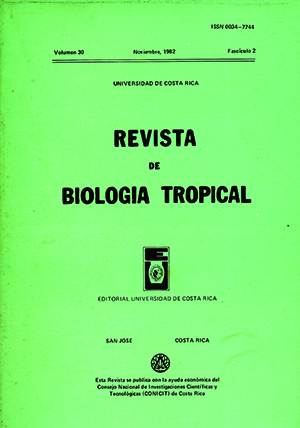Abstract
The salinity gradient in the mangrove swamps of a bay in Guanacaste, Costa Rica is closely related to edaphic and climatic conditions and greatly affects the floristic composition, zonation and structural characteristics of the mangrove community. High salinities stunt growth, and reduce the basal area of the individual trees and the size of the leaves. Tolerance of some species to high salinity was greater than previously known; Avicennia germinans was found growing in areas of up to 1550/00, with annual averages of 100.50/00.References
Bacon, P. R. 1970. The Ecology of Caroni Swamp, Trinidad. Spec. Pub. Central Statistical Off., Trinidad. 68 p.
Barbour, M.G., J.H. Burk & W.D. Pitts. 1980. Terrestrial Plant Ecology. The Benjamin/Cummings Publishing Company Inc. California. 604 p.
Blasco, F., C. Caratini, S. Chanda, & G. Thanikaimoni. 1975. Main characteristics of Indian mangroves, p. 8-11. In G.E. Walsh, S. C. Snedaker. H.J. Teas (eds.). Proc. Int. Symposium in Biology and Management of Mangroves. Univ. of. Florida, Gainesville.
Bole, P.V., & F.R, Bharucha. 1954. Osmotic relations of the leaves of Avicennia alba BI. J. Univ. Bombay 22: 50-54.
Castaing, A, J.M. Jiménez, & C.R. Villalobos. 1980. Observaciones sobre la ecología de los manglares de la costa Pacífica de Costa Rica y su relación con la distribución del molusco Geloina inflara (Philippi). Rev. Biol. Trop., 28: 323-339.
Cintron, G., C. Goenaga, & A.E. Lugo. 1980. Observaciones sobre el desarrollo del manglar en costas áridas. In Estudio científico e impacto humano en el ecosistema de manglares. UNESCO, Montevideo.
Cintron, G., A.E. Lugo, D.J. Pool, & G. Morris. 1978. Mangroves of arid environments in Puerto Rico and adjacent islands. Biotropica, 10: 110-121.
Cottam, G., & J.T. Curtis. 1956. The use of distance measures in phytosociological sampling. Ecology, 37: 451-460.
Curtis, J., & R.P. McIntosh. 1951. An upland forest continuum in the prairie-forest border region of Wisconsin. Ecology, 32: 476-498.
Faber, F. C. von. 1 923. Zur Physiologie der Mangroven. Ber. Dtsch. Bot. Ges., 41: 227-234.
Folk, R. L. 1974. Petrology of Sedimentary Rocks. Hemphill Publishing Co. Texas. 182 p.
Gale, J. 1975: Water balance and gas exchange of plants under saline conditions. In A Poljakoff-Mayher & J. Gale (eds.). Plants in saline environments. Springer - verlag. N.Y. 213 p.
Giglioli, M.E., & D.F. King. 1967. The mangrove swamps of Keneba, Lower Cambia Rivei: Basin. J. Appl. Ecol., 3: 1-19.
Godoy, J. C. 1980. Distribución, composición florística y análisis estructural del manglar de las Lisas. Tesis de Grado, Universidad de San Carlos, Guatemala.
Holdridge, L.R. 1940. Some notes on the mangrove swamps of Puerto Rico. Caribb. For., 1: 19-29.
Holdridge. L.R. 1947. Life zone ecology. Tropical Science Center, San José, Costa Rica. 206 p.
Jiménez, J.A. 1981. The mangroves of Costa Rica: A physiognomic characterization. Master's Thesis, University of Miami, Coral Gables, Florida, U.S.A.
Johnstone, I.M. 1980. Consumption of leaves by hervibores in mixed mangrove stands. Biotropica, 13: 252-259.
Leshem, Y., & E. Levison. 1972. Regulation mechanisms in the salt mangrove Avicennia marina growing in the Sinai littoral. Ecol. Plant., 7: 167-176.
Lotshert, W. 1955. La vegetación de El Salvador. Comun. lnst. Trop. Invest. Cient., 4: 65-79.
Lugo, A.E., G. Evink, M. Brinson, A. Broce, & S. Snedaker. 1975. Diurnal rates of photosynthesis, respiration and transpiration in mangrove forests of South Florida, In F. B. Golley & E. Medina (eds.). Tropical ecological Systems. Springer-Verlag. N.Y. 335 p.
Macnae, W. 1966. Mangroves in Eastern and Southern Australia. Aust. J. Bot., 14: 67-104.
Macnae, W. 1968. A General account of the fauna and flora of mangrove swamps and forests in the Indo-Western Pacific region. Advances in Marine Biology, 6: 73-270.
Mizrachi, D., R. Pannier, & F. Pannier. 1980. Assesment of Salt Resistance Mechanisms as determinant physio-ecological parameters of zonal distribution of mangrove species. Bot. Mar., 23: 289-296.
Pascua, N.B. 1980. Características filosociológicas de los manglares en el Parque Nacional Tayrona, p. 33-45. In Estudio Científico e impacto Humano en el Ecosistema de Manglares. UNESCO. Montevideo.
Pool, D.J., S.C. Snedaker, & A.E. Lugo. 1977. Structure of mangrove Forests in Florida, Puerto Rico, México and Costa Rica. Biotropica, 9: 194-212.
Rains, D.W., & E. Epstein. 1967. Preferencial absorption of potassium by leaf tissue of the man grove Avicennia marina: an aspect of halophytic competence in coping with salt. Austr. J. Biol. Sci, 20: 847-857.
Smith, F.G. Walton, ed. 1974. Handbook of Marine Sciences. Vol. I. CRC Press.
Semeniuk, V. 1 980. Mangrove zonation along an eroding coast line in King Sound, Northwestern Australia. J. Ecol., 68: 789-812.
Scholander, P.F., H.T. Ha, E.E. Bradstreet, & E.A. Hemmingsen; 1965. Sap pressure in vascular plants. Science, 148: 339-345.
Taylor, B.W. 1959. The classification of low land swamp communities in northeastern Papua. Ecology, 40: 703-711.
Tosi, J.A. 1969. República de Costa Rica, Mapa Ecológico. Escala 1: 750000. Centro Científico Tropical. San losé, Costa Rica.
West, R.C. 1977. Tidal salt-marsh and mangal formations of Middle and South America. In V.J. Chapman (ed.). Wet Coastal Ecosystems. Elsevier Scientific Publishing Company. N.Y. 428 p.
Weyl, R. 1953. In den Mangroven El Salvador. Natur. u. Volk, 83: 120-130.

This work is licensed under a Creative Commons Attribution 4.0 International License.
Copyright (c) 1982 Revista de Biología Tropical

